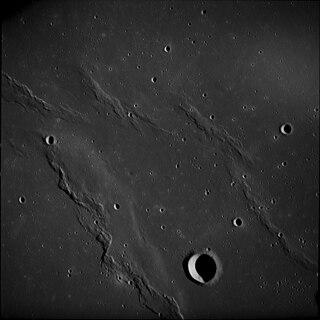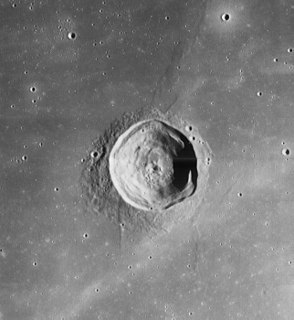
Ångström is a small lunar impact crater located on the border between Oceanus Procellarum to the west and Mare Imbrium to the east. To the south is a formation of mountains rising out of the mare named the Montes Harbinger. To the east are some wrinkle ridges named the Dorsum Bucher and Dorsa Argand. This crater is bowl-shaped, with a circular rim and inner walls that slope down to the small central floor. It has a higher albedo than the surrounding maria.
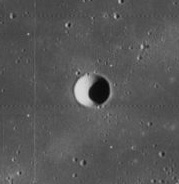
Zinner is a tiny lunar impact crater located due north of the crater Schiaparelli on the Oceanus Procellarum. It is circular and cup-shaped, with a high albedo in comparison to the surrounding lunar mare. The crater has essentially no rim because the mare lava nearly flooded it. A ray from the crater Glushko crosses Zinner. To the northwest is the slightly larger crater Golgi. East of Zinner is the Dorsa Burnet wrinkle ridge system.

Very is a small lunar impact crater located in the eastern part of Mare Serenitatis, to the west-southwest of Le Monnier. It lies upon a wrinkle ridge that runs to the north and south named Dorsa Smirnov. It was named after American astronomer Frank W. Very. The crater was previously known as Le Monnier B, a satellite crater of Le Monnier, before being renamed by the IAU in 1973.

Fahrenheit is a tiny lunar impact crater located in the southeast part of the Mare Crisium. This area of the surface is nearly devoid of impact features of interest. To the east are the Dorsa Harker wrinkle ridges, and beyond them is Promontorium Agarum at the edge of the mare. The landing site of the Soviet Luna 24 probe is located about 15 kilometers to the southeast.

Cajal is a small lunar impact crater on the northern part of the Mare Tranquilitatis. It was named after the Spanish doctor and Nobel laureate Santiago Ramón y Cajal. It is a circular, cup-shaped formation that lies southeast of the lava-inundated crater Jansen. Cajal was formerly designated Jansen F. Also to the northwest is a system of wrinkle ridges designated the Dorsa Barlow.

Webb is a small lunar impact crater that is located near the eastern edge of the Mare Fecunditatis, in the eastern part of the Moon near the equator. It was named after British astronomer Thomas William Webb. It is to the north of the prominent crater Langrenus, and west of Maclaurin.
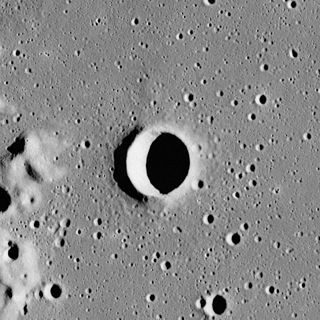
Scheele is a tiny, bowl-shaped lunar impact crater that lies on the Oceanus Procellarum, to the south of the small crater Wichmann. To the southwest is the flooded crater Letronne. To the southwest of Scheele are several low ridges projecting above the surface of the lunar mare, the Dorsa Ewing.

Mons Hadley is a massif in the northern portion of the Montes Apenninus, a range in the northern hemisphere of the Moon. It has a height of 4.2 km (14,000 ft) above the adjacent plain and a maximum diameter of 25 km at the base.
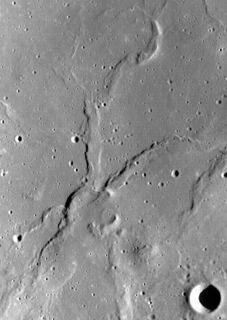
Dorsa Andrusov is a wrinkle ridge system at 1.0°S 57.0°E in Mare Fecunditatis on the Moon. It is 160 km in diameter and was named after Soviet geologist Nicolai Ivanovich Andrusov in 1976 by the IAU.
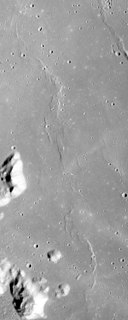
Dorsa Argand is a wrinkle ridge system at 28.1°N 40.6°W on the Moon, in Oceanus Procellarum near the border with Mare Imbrium. It is approximately 92 km long and was named after Swiss geologist Émile Argand in 1976. The name of the feature was approved by the IAU in 1976.

Dorsa Smirnov is a wrinkle ridge system at 27.3°N 25.3°E in eastern Mare Serenitatis on the Moon. It is 222 km long and was named after Soviet geologist Sergei Sergeevich Smirnov by the IAU in 1976.

Dorsa Cato is a wrinkle ridge at 1.0°N 47.0°E on the Moon. It is approximately 130 km long and was named after Roman geological engineer Cato the Elder in 1976 by the IAU.
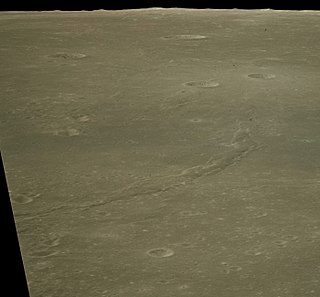
Dorsa Geikie is a wrinkle ridge at 4.6°S 52.5°E in Mare Fecunditatis on the Moon. It is approximately 220 km long and was named after Scottish geologist Sir Archibald Geikie in 1976 by the IAU.
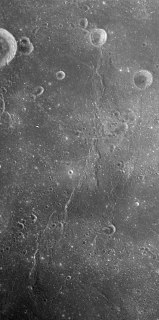
Dorsa Mawson is a wrinkle ridge system at 7.0°S 53.0°E in Mare Fecunditatis on the Moon. It is approximately 143 km long and was named after Antarctic explorer Douglas Mawson in 1979 by the IAU.
Dorsa Stille is a wrinkle ridge system at 27.0°N 19.0°W in Mare Imbrium on the Moon. It is 66 km long and was named after German geologist Hans Stille in 1976.

Dorsum Cayeux is a wrinkle ridge at 1.6°N 51.2°E in Mare Fecunditatis on the Moon. It is approximately 95 km long and was named after French geologist Lucien Cayeux in 1976 by the IAU.
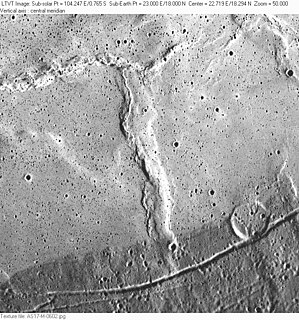
Dorsum Nicol is a wrinkle ridge on the Moon at 18.0°N 23.0°E in Mare Serenitatis near the border of Mare Tranquilitatis. It is 44 km long and was named after Scottish physicist William Nicol in 1976.

Tyndall is an impact crater in the Cebrenia quadrangle of Mars, located at 40.0°N latitude and 190.1°W longitude. It measures approximately 87 kilometers in diameter and was named after Irish physicist John Tyndall (1820–1893). The name was approved in 1973, by the International Astronomical Union (IAU) Working Group for Planetary System Nomenclature.

Gill Crater is an impact crater in the Arabia quadrangle of Mars, located at 15.9°N latitude and 354.6°W longitude. It is 83.0 km in diameter and was named after David Gill (astronomer), and the name was approved in 1973 by the International Astronomical Union (IAU) Working Group for Planetary System Nomenclature (WGPSN).

